Leadership & Change Management: Blog Discussions & Perspectives
VerifiedAdded on 2023/06/16
|7
|1281
|390
Discussion Board Post
AI Summary
This assignment comprises blog posts discussing various aspects of organizational change management. It addresses the nature of organizational change, its drivers, and common types, emphasizing the importance of effective communication and planning. The blogs also explore the necessity for contemporary organizations to adapt to internal and external changes through technology and employee empowerment. Furthermore, it identifies reasons for the failure of change programs, such as poor communication, inadequate planning, lack of employee involvement, and insufficient support from leadership. The discussion highlights the need for structured approaches and continuous monitoring to ensure successful implementation of change initiatives. Desklib provides a platform for students to access this and other solved assignments.
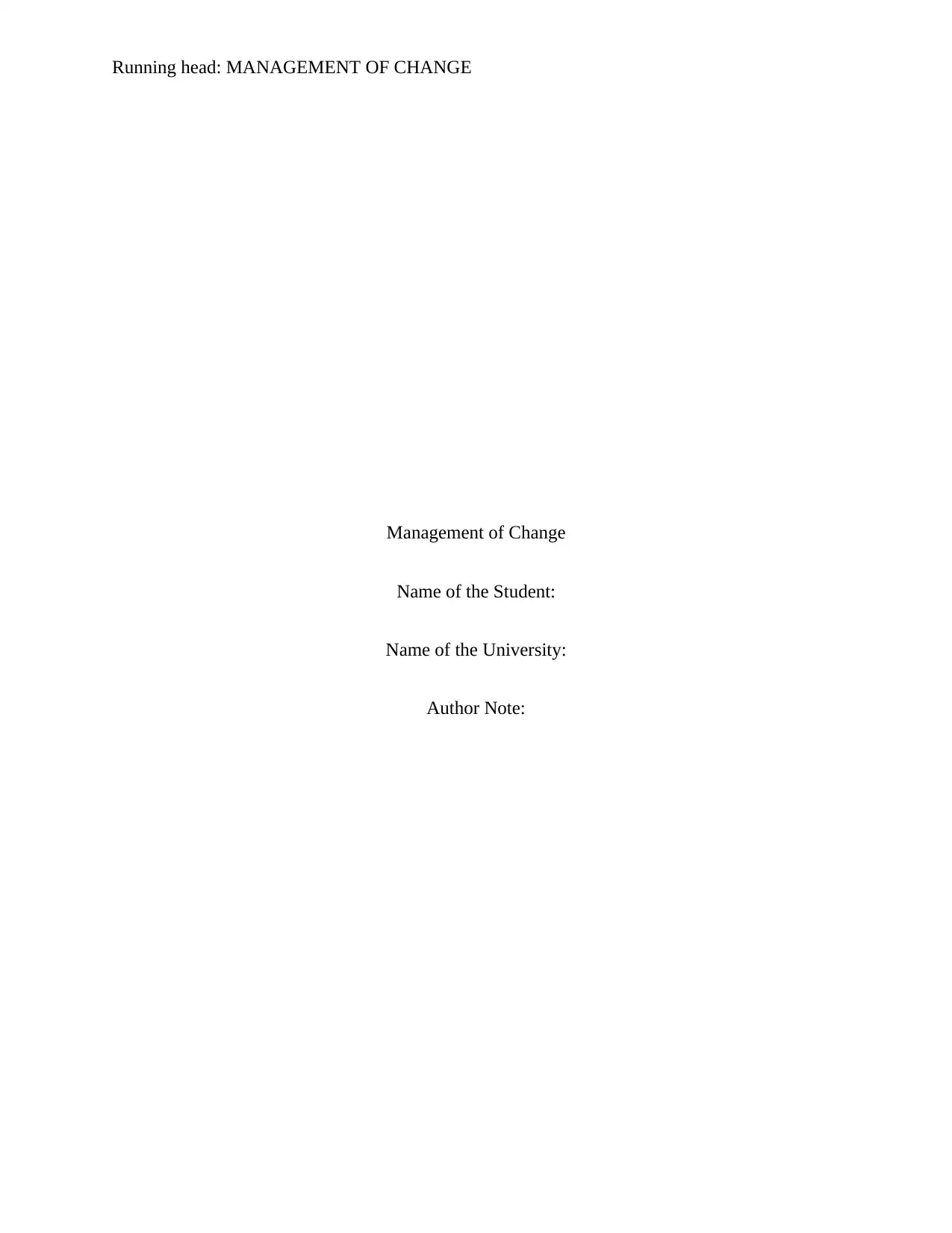
Running head: MANAGEMENT OF CHANGE
Management of Change
Name of the Student:
Name of the University:
Author Note:
Management of Change
Name of the Student:
Name of the University:
Author Note:
Paraphrase This Document
Need a fresh take? Get an instant paraphrase of this document with our AI Paraphraser
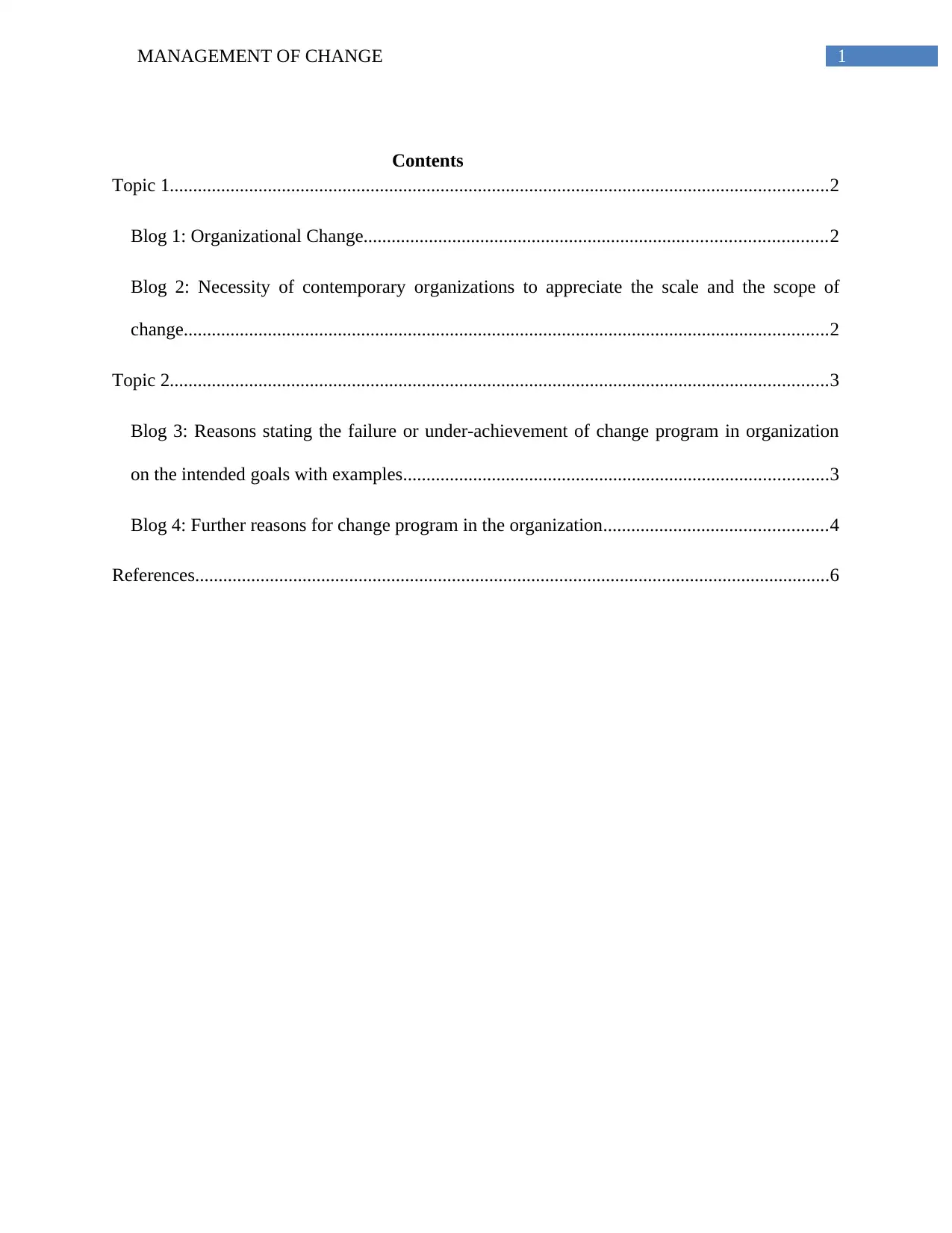
1MANAGEMENT OF CHANGE
Contents
Topic 1.............................................................................................................................................2
Blog 1: Organizational Change...................................................................................................2
Blog 2: Necessity of contemporary organizations to appreciate the scale and the scope of
change..........................................................................................................................................2
Topic 2.............................................................................................................................................3
Blog 3: Reasons stating the failure or under-achievement of change program in organization
on the intended goals with examples...........................................................................................3
Blog 4: Further reasons for change program in the organization................................................4
References........................................................................................................................................6
Contents
Topic 1.............................................................................................................................................2
Blog 1: Organizational Change...................................................................................................2
Blog 2: Necessity of contemporary organizations to appreciate the scale and the scope of
change..........................................................................................................................................2
Topic 2.............................................................................................................................................3
Blog 3: Reasons stating the failure or under-achievement of change program in organization
on the intended goals with examples...........................................................................................3
Blog 4: Further reasons for change program in the organization................................................4
References........................................................................................................................................6
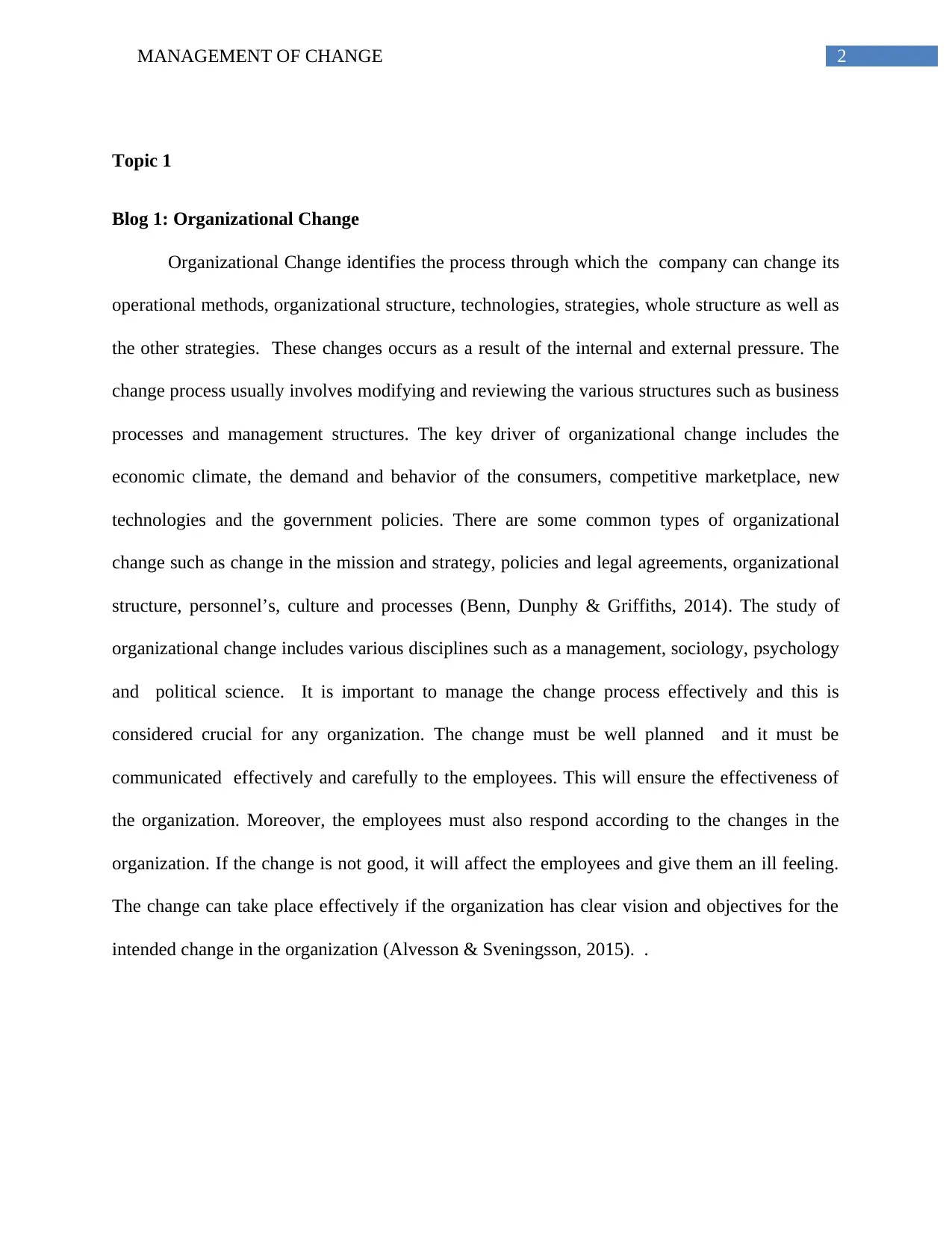
2MANAGEMENT OF CHANGE
Topic 1
Blog 1: Organizational Change
Organizational Change identifies the process through which the company can change its
operational methods, organizational structure, technologies, strategies, whole structure as well as
the other strategies. These changes occurs as a result of the internal and external pressure. The
change process usually involves modifying and reviewing the various structures such as business
processes and management structures. The key driver of organizational change includes the
economic climate, the demand and behavior of the consumers, competitive marketplace, new
technologies and the government policies. There are some common types of organizational
change such as change in the mission and strategy, policies and legal agreements, organizational
structure, personnel’s, culture and processes (Benn, Dunphy & Griffiths, 2014). The study of
organizational change includes various disciplines such as a management, sociology, psychology
and political science. It is important to manage the change process effectively and this is
considered crucial for any organization. The change must be well planned and it must be
communicated effectively and carefully to the employees. This will ensure the effectiveness of
the organization. Moreover, the employees must also respond according to the changes in the
organization. If the change is not good, it will affect the employees and give them an ill feeling.
The change can take place effectively if the organization has clear vision and objectives for the
intended change in the organization (Alvesson & Sveningsson, 2015). .
Topic 1
Blog 1: Organizational Change
Organizational Change identifies the process through which the company can change its
operational methods, organizational structure, technologies, strategies, whole structure as well as
the other strategies. These changes occurs as a result of the internal and external pressure. The
change process usually involves modifying and reviewing the various structures such as business
processes and management structures. The key driver of organizational change includes the
economic climate, the demand and behavior of the consumers, competitive marketplace, new
technologies and the government policies. There are some common types of organizational
change such as change in the mission and strategy, policies and legal agreements, organizational
structure, personnel’s, culture and processes (Benn, Dunphy & Griffiths, 2014). The study of
organizational change includes various disciplines such as a management, sociology, psychology
and political science. It is important to manage the change process effectively and this is
considered crucial for any organization. The change must be well planned and it must be
communicated effectively and carefully to the employees. This will ensure the effectiveness of
the organization. Moreover, the employees must also respond according to the changes in the
organization. If the change is not good, it will affect the employees and give them an ill feeling.
The change can take place effectively if the organization has clear vision and objectives for the
intended change in the organization (Alvesson & Sveningsson, 2015). .
⊘ This is a preview!⊘
Do you want full access?
Subscribe today to unlock all pages.

Trusted by 1+ million students worldwide
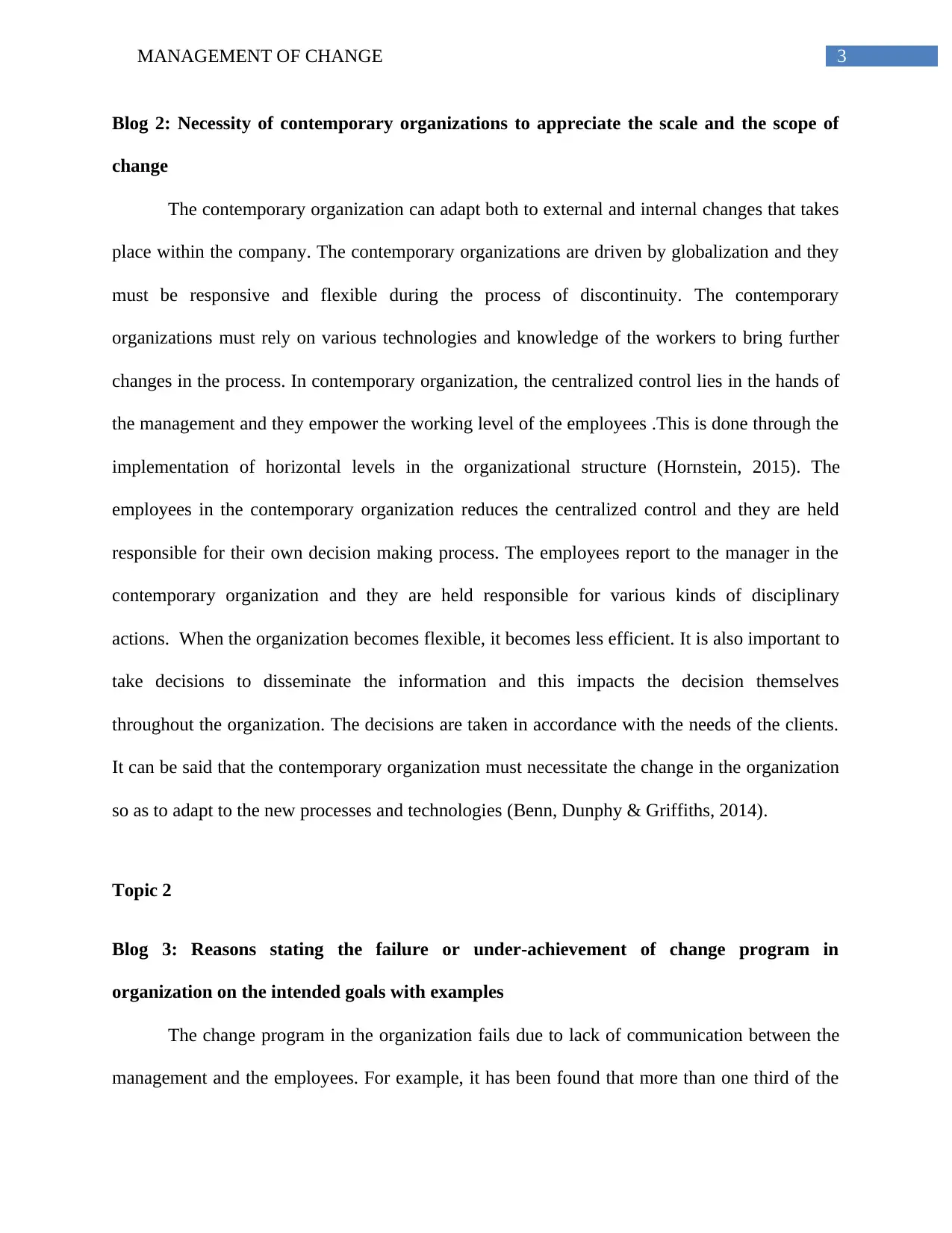
3MANAGEMENT OF CHANGE
Blog 2: Necessity of contemporary organizations to appreciate the scale and the scope of
change
The contemporary organization can adapt both to external and internal changes that takes
place within the company. The contemporary organizations are driven by globalization and they
must be responsive and flexible during the process of discontinuity. The contemporary
organizations must rely on various technologies and knowledge of the workers to bring further
changes in the process. In contemporary organization, the centralized control lies in the hands of
the management and they empower the working level of the employees .This is done through the
implementation of horizontal levels in the organizational structure (Hornstein, 2015). The
employees in the contemporary organization reduces the centralized control and they are held
responsible for their own decision making process. The employees report to the manager in the
contemporary organization and they are held responsible for various kinds of disciplinary
actions. When the organization becomes flexible, it becomes less efficient. It is also important to
take decisions to disseminate the information and this impacts the decision themselves
throughout the organization. The decisions are taken in accordance with the needs of the clients.
It can be said that the contemporary organization must necessitate the change in the organization
so as to adapt to the new processes and technologies (Benn, Dunphy & Griffiths, 2014).
Topic 2
Blog 3: Reasons stating the failure or under-achievement of change program in
organization on the intended goals with examples
The change program in the organization fails due to lack of communication between the
management and the employees. For example, it has been found that more than one third of the
Blog 2: Necessity of contemporary organizations to appreciate the scale and the scope of
change
The contemporary organization can adapt both to external and internal changes that takes
place within the company. The contemporary organizations are driven by globalization and they
must be responsive and flexible during the process of discontinuity. The contemporary
organizations must rely on various technologies and knowledge of the workers to bring further
changes in the process. In contemporary organization, the centralized control lies in the hands of
the management and they empower the working level of the employees .This is done through the
implementation of horizontal levels in the organizational structure (Hornstein, 2015). The
employees in the contemporary organization reduces the centralized control and they are held
responsible for their own decision making process. The employees report to the manager in the
contemporary organization and they are held responsible for various kinds of disciplinary
actions. When the organization becomes flexible, it becomes less efficient. It is also important to
take decisions to disseminate the information and this impacts the decision themselves
throughout the organization. The decisions are taken in accordance with the needs of the clients.
It can be said that the contemporary organization must necessitate the change in the organization
so as to adapt to the new processes and technologies (Benn, Dunphy & Griffiths, 2014).
Topic 2
Blog 3: Reasons stating the failure or under-achievement of change program in
organization on the intended goals with examples
The change program in the organization fails due to lack of communication between the
management and the employees. For example, it has been found that more than one third of the
Paraphrase This Document
Need a fresh take? Get an instant paraphrase of this document with our AI Paraphraser
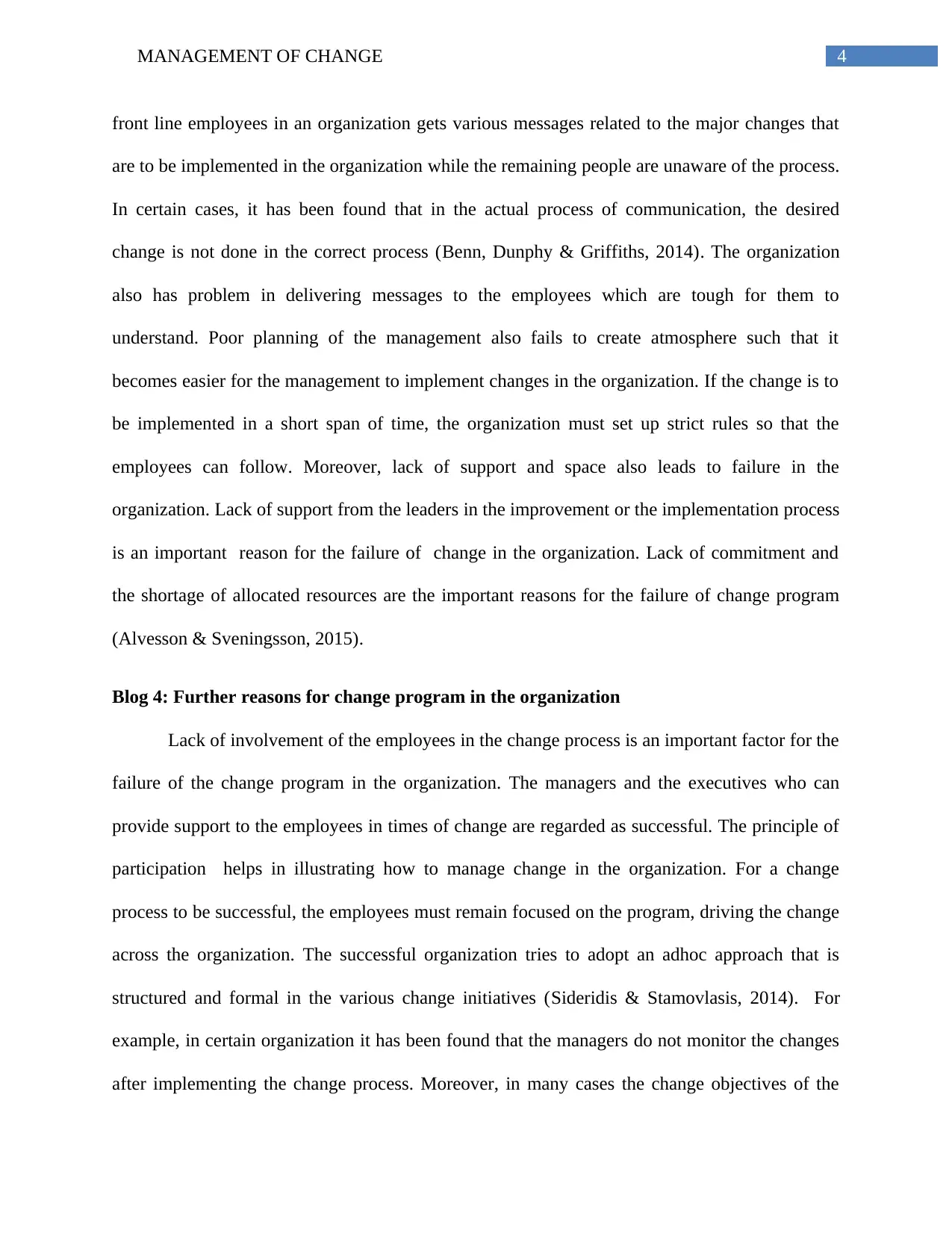
4MANAGEMENT OF CHANGE
front line employees in an organization gets various messages related to the major changes that
are to be implemented in the organization while the remaining people are unaware of the process.
In certain cases, it has been found that in the actual process of communication, the desired
change is not done in the correct process (Benn, Dunphy & Griffiths, 2014). The organization
also has problem in delivering messages to the employees which are tough for them to
understand. Poor planning of the management also fails to create atmosphere such that it
becomes easier for the management to implement changes in the organization. If the change is to
be implemented in a short span of time, the organization must set up strict rules so that the
employees can follow. Moreover, lack of support and space also leads to failure in the
organization. Lack of support from the leaders in the improvement or the implementation process
is an important reason for the failure of change in the organization. Lack of commitment and
the shortage of allocated resources are the important reasons for the failure of change program
(Alvesson & Sveningsson, 2015).
Blog 4: Further reasons for change program in the organization
Lack of involvement of the employees in the change process is an important factor for the
failure of the change program in the organization. The managers and the executives who can
provide support to the employees in times of change are regarded as successful. The principle of
participation helps in illustrating how to manage change in the organization. For a change
process to be successful, the employees must remain focused on the program, driving the change
across the organization. The successful organization tries to adopt an adhoc approach that is
structured and formal in the various change initiatives (Sideridis & Stamovlasis, 2014). For
example, in certain organization it has been found that the managers do not monitor the changes
after implementing the change process. Moreover, in many cases the change objectives of the
front line employees in an organization gets various messages related to the major changes that
are to be implemented in the organization while the remaining people are unaware of the process.
In certain cases, it has been found that in the actual process of communication, the desired
change is not done in the correct process (Benn, Dunphy & Griffiths, 2014). The organization
also has problem in delivering messages to the employees which are tough for them to
understand. Poor planning of the management also fails to create atmosphere such that it
becomes easier for the management to implement changes in the organization. If the change is to
be implemented in a short span of time, the organization must set up strict rules so that the
employees can follow. Moreover, lack of support and space also leads to failure in the
organization. Lack of support from the leaders in the improvement or the implementation process
is an important reason for the failure of change in the organization. Lack of commitment and
the shortage of allocated resources are the important reasons for the failure of change program
(Alvesson & Sveningsson, 2015).
Blog 4: Further reasons for change program in the organization
Lack of involvement of the employees in the change process is an important factor for the
failure of the change program in the organization. The managers and the executives who can
provide support to the employees in times of change are regarded as successful. The principle of
participation helps in illustrating how to manage change in the organization. For a change
process to be successful, the employees must remain focused on the program, driving the change
across the organization. The successful organization tries to adopt an adhoc approach that is
structured and formal in the various change initiatives (Sideridis & Stamovlasis, 2014). For
example, in certain organization it has been found that the managers do not monitor the changes
after implementing the change process. Moreover, in many cases the change objectives of the
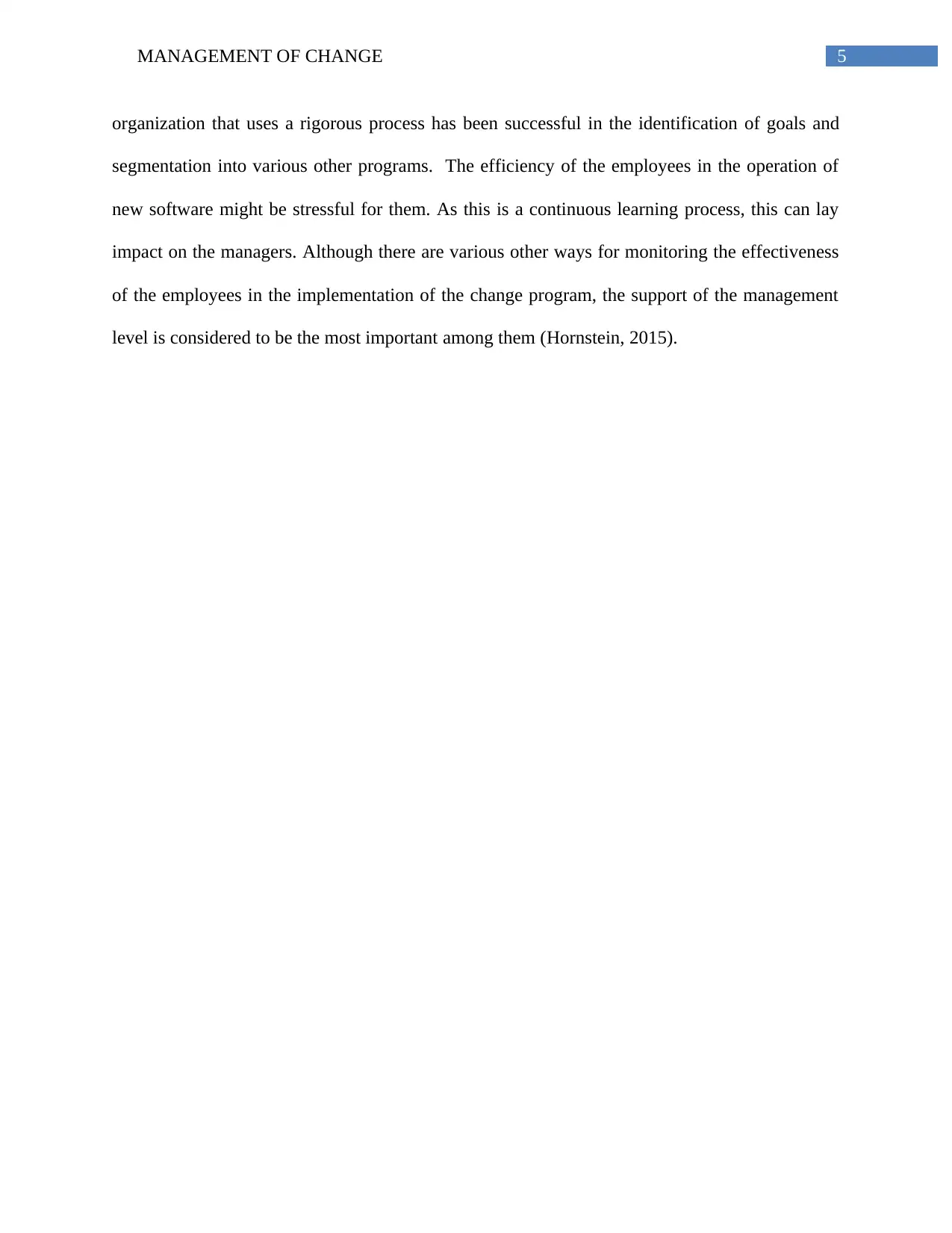
5MANAGEMENT OF CHANGE
organization that uses a rigorous process has been successful in the identification of goals and
segmentation into various other programs. The efficiency of the employees in the operation of
new software might be stressful for them. As this is a continuous learning process, this can lay
impact on the managers. Although there are various other ways for monitoring the effectiveness
of the employees in the implementation of the change program, the support of the management
level is considered to be the most important among them (Hornstein, 2015).
organization that uses a rigorous process has been successful in the identification of goals and
segmentation into various other programs. The efficiency of the employees in the operation of
new software might be stressful for them. As this is a continuous learning process, this can lay
impact on the managers. Although there are various other ways for monitoring the effectiveness
of the employees in the implementation of the change program, the support of the management
level is considered to be the most important among them (Hornstein, 2015).
⊘ This is a preview!⊘
Do you want full access?
Subscribe today to unlock all pages.

Trusted by 1+ million students worldwide
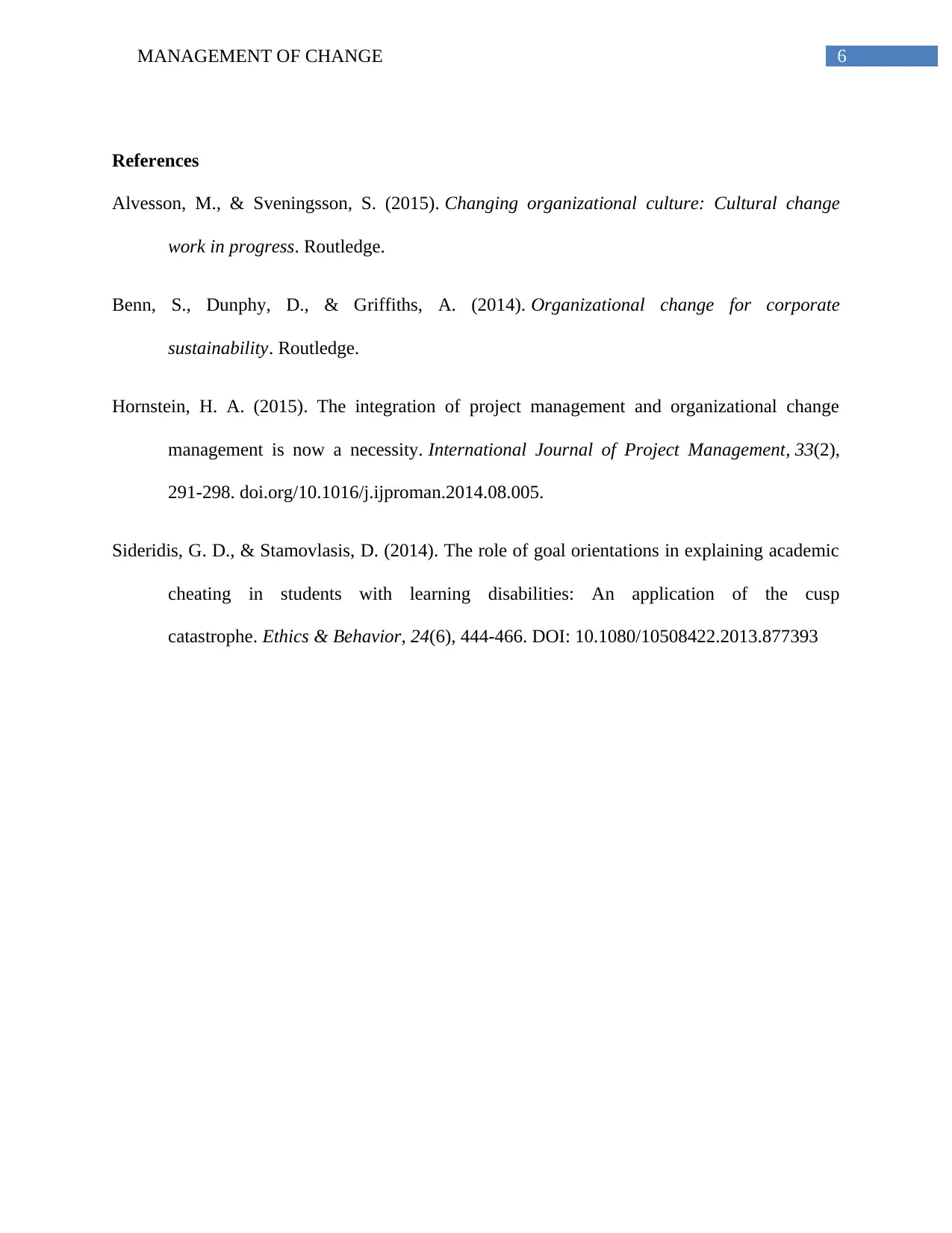
6MANAGEMENT OF CHANGE
References
Alvesson, M., & Sveningsson, S. (2015). Changing organizational culture: Cultural change
work in progress. Routledge.
Benn, S., Dunphy, D., & Griffiths, A. (2014). Organizational change for corporate
sustainability. Routledge.
Hornstein, H. A. (2015). The integration of project management and organizational change
management is now a necessity. International Journal of Project Management, 33(2),
291-298. doi.org/10.1016/j.ijproman.2014.08.005.
Sideridis, G. D., & Stamovlasis, D. (2014). The role of goal orientations in explaining academic
cheating in students with learning disabilities: An application of the cusp
catastrophe. Ethics & Behavior, 24(6), 444-466. DOI: 10.1080/10508422.2013.877393
References
Alvesson, M., & Sveningsson, S. (2015). Changing organizational culture: Cultural change
work in progress. Routledge.
Benn, S., Dunphy, D., & Griffiths, A. (2014). Organizational change for corporate
sustainability. Routledge.
Hornstein, H. A. (2015). The integration of project management and organizational change
management is now a necessity. International Journal of Project Management, 33(2),
291-298. doi.org/10.1016/j.ijproman.2014.08.005.
Sideridis, G. D., & Stamovlasis, D. (2014). The role of goal orientations in explaining academic
cheating in students with learning disabilities: An application of the cusp
catastrophe. Ethics & Behavior, 24(6), 444-466. DOI: 10.1080/10508422.2013.877393
1 out of 7
Related Documents
Your All-in-One AI-Powered Toolkit for Academic Success.
+13062052269
info@desklib.com
Available 24*7 on WhatsApp / Email
![[object Object]](/_next/static/media/star-bottom.7253800d.svg)
Unlock your academic potential
Copyright © 2020–2025 A2Z Services. All Rights Reserved. Developed and managed by ZUCOL.



